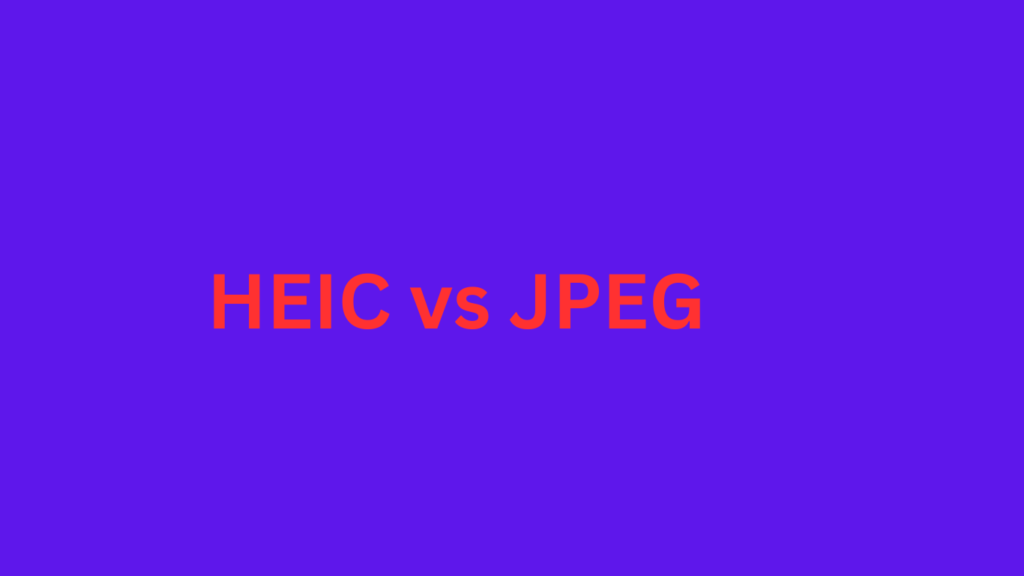image compression, two formats have emerged as prominent contenders: HEIC and JPEG. These two file formats represent different approaches to balancing image quality and file size. Each format has its own set of advantages and disadvantages, and understanding the differences between HEIC and JPEG is very important. In this article, we will delve into the characteristics, image quality, file size, compatibility, and more of HEIC and JPEG to help you navigate the ever-evolving landscape of digital image formats
Image File Format: HEIC vs JPEG
Certainly! Here’s a comparison box highlighting the key differences between the image file formats HEIC and JPEG:
Metadata | Supports advanced metadata, including depth maps and multiple image layers | Basic metadata support, such as EXIF data, but lacks advanced features |
Storage Space Savings | Offers significant savings in terms of storage space | Offers reasonable savings but may not match HEIC’s efficiency |
Editing Flexibility | Allows for non-destructive edits and adjustments due to multiple image layers | Edits can lead to a slight degradation in image quality over time |
Popular Usage | Commonly used on Apple devices and some newer Android smartphones | Ubiquitous format used across all digital platforms and devices |
Licensing | Patented format, subject to licensing fees in some cases | Open and widely available without licensing restrictions |
These differences can significantly impact your choice of image format depending on your specific needs and the devices and software you use for viewing and editing images.
Who Should Consider Using HEIC?
HEIC, or High Efficiency Image Format, offers several advantages that make it a compelling choice for certain. Here are some groups and situations where considering the use of HEIC may be particularly beneficial:
Apple Device Users:
HEIC is the default image format for Apple devices, including iPhones and iPads. If you use these devices frequently, you’ll benefit from the space-saving advantages of HEIC, which can help you maximize your device’s storage capacity.
Photographers and Creatives:
HEIC supports advanced features like High Dynamic Range (HDR) and multiple image layers. Photographers and creatives who need to capture and edit high-quality images may find HEIC valuable for preserving image details and allowing for non-destructive editing.
Storage-Conscious Users:
If you often struggle with limited storage space on your devices, HEIC’s superior compression efficiency can help you store more images without sacrificing too much quality. This is especially useful for users with devices that don’t have expandable storage options.
iOS Ecosystem Integration:
If you use various Apple devices, HEIC ensures seamless compatibility and efficient image transfer between them. This can simplify your workflow, as you won’t need to convert or resize images for different devices.
Privacy-Conscious Users:
HEIC supports encryption for image files, providing an extra layer of security for your photos. This can be particularly appealing to users who prioritize data privacy.
Users with Modern Devices:
Newer Android smartphones and devices running modern operating systems have started to support HEIC. If you own one of these devices, you can benefit from HEIC’s advantages, even if you’re not exclusively in the Apple ecosystem.
Non-Destructive Editing:
For users who frequently edit their photos and want to maintain the highest possible quality during the image editing process, HEIC’s support for multiple image layers and lossless compression can be advantageous.
Where JPEG Is Still Preferable?
Here are situations where JPEG is still preferable:
Universal Compatibility:
JPEG is one of the most widely supported image formats across various platforms, devices, and software applications. If you need to ensure that your images are accessible and viewable by the widest possible audience, JPEG is the go-to format.
Legacy Devices and Software:
Older devices and software may not support HEIC or other newer image formats. JPEG’s longstanding presence in the industry makes it the safest choice when dealing with legacy technology.
Web and Online Sharing:
JPEG remains the primary format for sharing images on websites, social media platforms, and email. It strikes a good balance between image quality and file size, making it ideal for quick and efficient image sharing online.
Lossy Compression Acceptable:
In cases where some loss of image quality is acceptable or imperceptible, such as web graphics or casual photography, JPEG’s lossy compression provides smaller file sizes without significant degradation in quality.
Editing Flexibility:
While HEIC has advantages for non-destructive editing, JPEG remains suitable for basic image editing tasks. Most photo editing software supports JPEG, making it a versatile choice for many editing needs.
Minimal Licensing Concerns:
JPEG is an open and widely available format without substantial licensing fees. This can be important for businesses and individuals concerned about intellectual property rights and costs.
Predictable Compression:
JPEG’s compression settings are well-understood and allow users to control the degree of compression applied to images. This predictability is valuable for those who want precise control over the final image quality and file size.
Finally
he choice between HEIC and JPEG ultimately boils down to a trade-off between compression efficiency and universal compatibility. Each format has its own set of strengths and weaknesses, making them suitable for distinct situations.HEIC shines in terms of compression efficiency and advanced features, making it an excellent choice for users with modern Apple devices, photographers who value image quality, and those concerned about storage space. Its ability to handle HDR and multiple image layers, coupled with lossless compression options, provides a compelling proposition for many users.
On the other hand, JPEG’s enduring popularity and universal compatibility make it the go-to format for scenarios where broad accessibility is paramount. It’s the standard for web and online sharing, as well as professional printing, and it remains a reliable choice for users with diverse hardware and software environments.
